Anyway, Here's WonderSwan (Part One)
By Mento 2 Comments
Like many occidental folks I've little to zero experience with Bandai's WonderSwan: a handheld console released in the late '90s to compete with Nintendo's iron grip over the market as a smaller-budget, longer-battery-life alternative. It was co-created by Koto Laboratory and its founder Gunpei Yokoi, a major figure in the development of the original Game Boy (as well as Metroid and a few other games) so Bandai definitely didn't go into this half-assed like they did with, say, almost every anime tie-in video game they published in the '90s. The original black and white graphics model came out in 1999 and the WonderSwan Color followed a year later, which in turn saw an updated model in the SwanCrystal in 2002. The standard and color versions saw approximately 100 games each and the system was considered a minor success, albeit not one that could survive for long against the overwhelming might of the Game Boy Advance (released 2001). No version of this system ever left Japan, at least not in an official context.
My original plan was to cherry-pick the most promising games from this undiscovered wilder(wonder?)ness of a library, but wouldn't you know it? The random selection apps I use for both Indie Game of the Week and 64 in 64 unionized recently, so now it seems I'm contractually obligated to offer them any additional choosing work that might arise. I guess it saves me the task of actually researching all this stuff ahead of time and if you've ever read one of my blogs you know how much I hate work and preparation and proofreading and all that tedious jazz. (Good thing I'm a pefect speller.)
So really this is just me playing a bunch of WonderSwan and WonderSwan Color games until I get bored—no sixty-four minute requirements here—and summarize what they're about and whether or not it was something we in the west really missed out on (both the game and, tacitly, the system as a whole). Hoping to find some gems here and there but realistically I think it'll be a sobering glimpse into a world trapped behind a language barrier where I can marvel at the vast number of anime licensed games we were never unfortunate enough to see. Privileged. I'm sure that's the word I meant.
Anyway, here's WonderSwan:
#001: Judgement Silversword -Rebirth Edition-
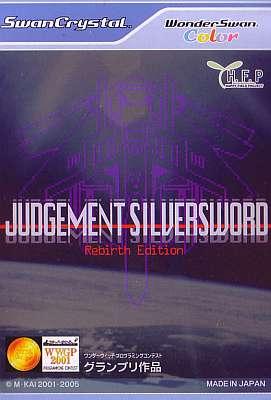
Field Report: Our first game is, perhaps fittingly, one of the last games ever released on WonderSwan. In fact, it emerged a year after the system was discontinued: reason being is that the original unfinished version of the game was the winner of a game development contest held in 2001 for the WonderWitch—a software development kit released by publishers Qute, the contest serving as a promotion for same. The reward for this contest was to have your game be released commercially, though I guess this retail version came a little late. You don't need a WonderSwan to play Silversword these days: the "Resurrection Edition" can be purchased directly from Steam or it can be played as a free bonus in the developer's later game Eschatos, which was localized and ported to PS4 and Switch as far back as 2022. If you're not familiar with Qute they tend to produce a lot of shoot 'em up throwbacks like Ginga Force and Natsuki Chronicles and this is definitely one of those. Despite being stuck on a portable system it's pretty busy, taking full advantage of the WonderSwan's hardware to have many sprites on the screen at once (albeit with some slowdown). Shoot 'em ups always tend to make good benchmarks for that sort of thing.
I actually had a pretty good time with Judgement Silversword, in part because it makes a lot of very smart choices that may have been more commonplace in the genre at that time (I've barely played anything shmup-related since the 16-bit generation so I couldn't say for sure). For one, there's no power-ups so you're as strong as you're ever going to be: no stressing about getting blown up and being in such a compromised state without all your add-ons that the rest of the game becomes impossible. You're able to switch between three firing modes instead: a focused stream which works best against mid-bosses and armored enemies; a spread shot which is ideal for when the screen is flooded with faster, weaker foes; and a shield that can absorb minor projectiles and delay major ones long enough to get out of their way, though blocking shots with it will rapidly deplete its power causing the area of effect to shrink. The shield in particular is a genius move, akin to the adjustable "Force" shield from R-Type, as it fixes the issue with vertical shoot 'em ups where you can easily run out of room to maneuver around heavy enemy fire with the limited horizontal space. Speaking of which, since the game is built to be a vertical scroller that means you have to hold the WonderSwan on its side N-Gage style and use an alternative control scheme, which is something Nintendo would eventually cotton onto as an idea for a few DS games.
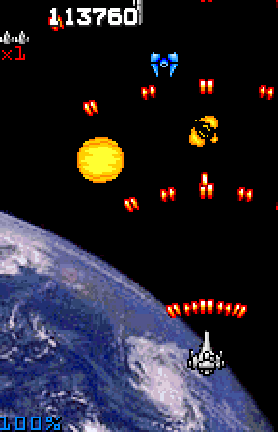
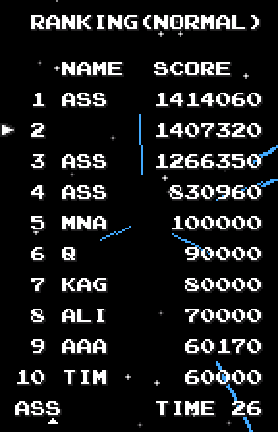
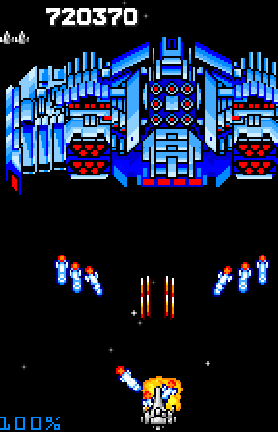
I got about as far as Area 9 on Normal mode where you meet the second boss and have to deal with some pretty intense patterns. I got twice as far on Easy but they take away the combo multiplier so my score was still far less than my best Normal run. I guess the Easy mode is better suited for learning patterns and seeing what the rest of the game is like. One last neat thing: there was a way to unlock main menu options based on your cumulative score, the first of which was being able to pause the game (cheeky). Couldn't seem to unlock others—maybe I need to make a certain amount of game progress in addition to the cumulative score milestones—but I wonder if it'll be things like giving yourself more lives and continues or possibly even some cheats or cosmetic changes. Neat game, though I am a little concerned that it'll all be downhill from here.
Time Spent: About half an hour.
#002: SD Gundam Eiyuuden: Musha Densetsu
("SD Gundam Heroes: Warrior Story")
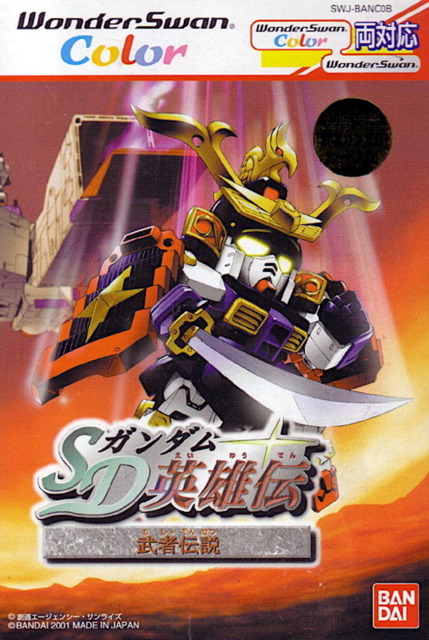
- Developer: Bec
- Publisher: Bandai
- Release Date: 2001-03-15
- Inscrutability: Maximum
- Is This Anime?: Sure is. Says "Gundam" right there. I know what a Gundam is.
Field Report: Oh boy, this was more in line with what I was expecting from a Bandai console. SD Gundam, which is a spin-off universe where the Gundams are their own sapient beings and have cute chibi appearances (i.e. super-deformed, or SD), was a popular license for tie-in games and there's eight of them for WonderSwan systems alone (three for b&w, five for color). Stories and games set in the SD Gundam universe might have the usual sci-fi setting but could also fall under the "Kishi" or "Musha" brands: the first being medieval knights and wizards and the second being traditional Japanese samurai and ninja. We're dealing with the latter here, though there was also a SD Gundam Eiyuuden: Kishi Densetsu that released the same day. Look forward to me pulling that on the next episode.
Hmm. A turn-based RPG with a whole lot of talking, is all I was about able to make out from playing this game for the brief duration I could stand. I'm not familiar with the SD Gundam Eiyuuden continuity (or, indeed, any Gundam continuity) but it seems like they go back to being giant robot suits in this game since the protagonists are a bunch of human teens that ride them around. We're tasked by what I believe is both the main character's daimyo (feudal lord) and father to help the soldiers in town fight off some enemy samurai Zakus. After beating their asses in a couple of easy fights I got stuck since I couldn't return to pops to report in, nor could I leave the town or enter any of the houses. If I had some other objective to complete I couldn't glean it from the Japanese script: since we're talking samurai and old-timey Japan there's a lot of kanji floating around I can't deal with.
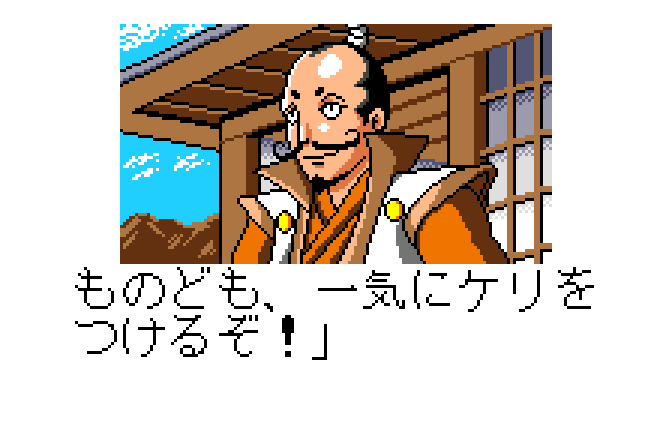
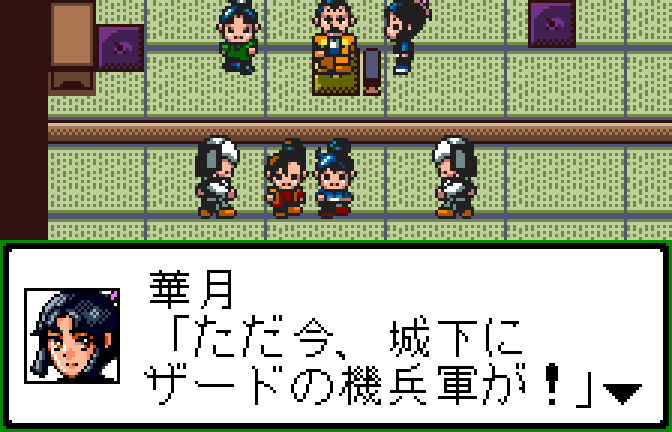
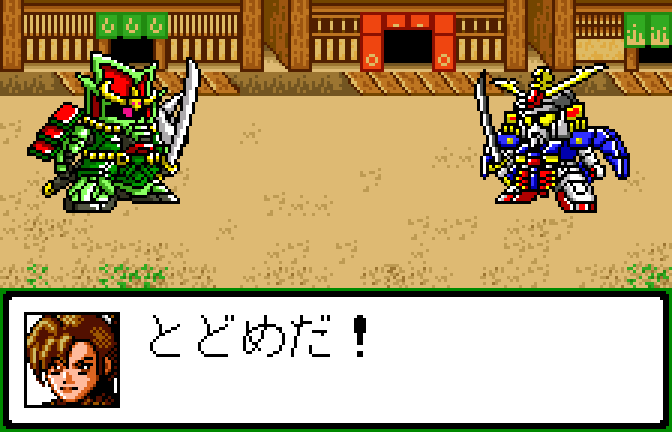
Yeah, so this one was a bust. I'm sure the system is jam-packed with RPGs, adventure games, and strategy games which are all going to need more fluency than I can muster—it would also help if I had any familiarity with the license too—but given how rudimentary this game appears I'm fairly sure I wouldn't want to play it start to finish even if I could follow it. These Dragon Quest clone types were everywhere for a while; here's hoping the next Gundam game I check out is an action title I can roll with for a bit longer. (Though I guess rolling out is more of a Transformers thing?)
Time Spent: Maybe 10 minutes?
#003: Flash Koibito-kun
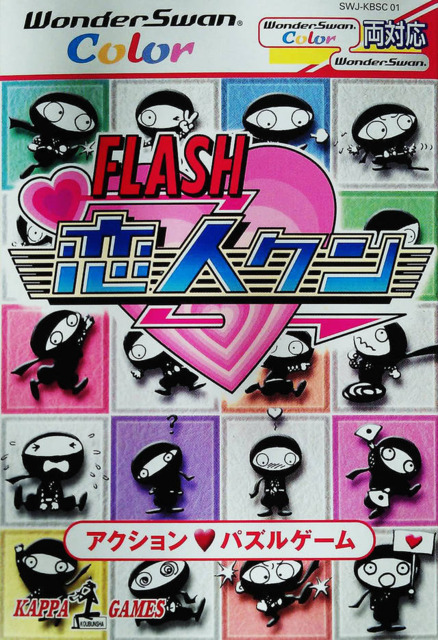
("Mr. Flash Lover" approx.)
- Developer: Koto Lab
- Publisher: Kobunsha
- Release Date: 2000-12-28
- Inscrutability: Minimum
- Is This Anime?: Maybe that "other" kind of anime. You know the one.
Field Report: We have our first Koto Lab game on here. If you didn't read the pre-amble (and why would you?) Koto was Gunpei Yokoi's baby and they focused on (extrapolating from this game) some classic Game Boy-ass puzzle games: the type that gave Nintendo's first portable system its identity as a little workhorse on the go that was best paired with something you could play for a few minutes while waiting for a bus, such as Tetris or Dr. Mario (and later the likes of Candy Crush and Angry Birds only went on to show what a prophetic vision that was). Flash Koibito-kun ("koibito" being the Japanese word for a romantic partner, though gender is unspecified) definitely feels like a cute puzzle game with enough nuance to it to grab hold of your attention for a while.
So, the idea is that the protagonist just got rejected by yet another woman and is feeling a mite forlorn about his love life. He passes by a shrine from which a kitsune-masked priest pops out with the promise of helping him with his problem by offering the services of what I assume is the eponymous character: a little ninja fellow whose job it is to ensure the protagonist's words of affection reach his target. The ninja does this by standing in gaps in a circuit that these heart-shaped affirmations follow so that they can complete their journey: each gap corresponds to a direction on the D-pad, so the player often has to bounce around quickly to make sure all the hearts make it to the end. That's the simple version. The advanced version is that you have another ability, a means of holding back hearts by blocking their path. By doing this the heart highway will become congested and form trains that can be a little harder to herd but will score way more love points once they reach their destination due to a combo bonus. Your target lady for that round will accept a certain number of special flashing hearts, so before they're all delivered you have to ensure you've built up enough large chains and brought them safely home to score the maximum three-heart rating. After each level the now swooning girl gives you some sweet talk in Japanese, though if you score the maximum rating these cutscenes are a little longer (though nothing licentious; the WonderSwan is a family system, after all).
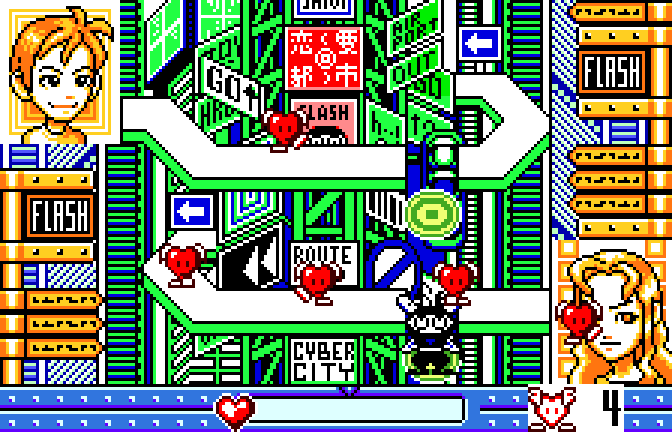

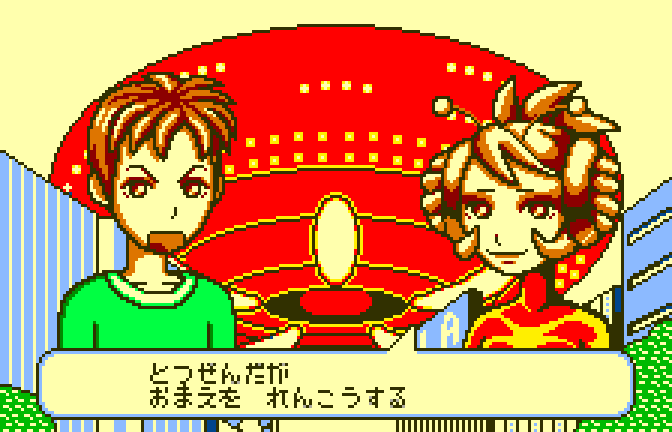
I progressed through the first two scenarios which had three levels/girls each—the dojo where you train with Mr. Flash Lover and the city where you try out the results of your training on random comely pedestrians—before I was plucked off the high street by a UFO and started macking on alien women instead. It did make me intensely curious what might proceed next after this little Urusei Yatsura twist but I figured I'd move on. The game's fun but it's also pretty basic for a game released in 2000: we were starting to reach the level of complexity in games (even portable games) where a cute little puzzle thing like this would only appear as a mini-game at most, like say in Mario Party 3 (which debuted the same month). I like the look of it though, adopting a more western-like art style for its characters—they sorta reminded me of that old pixel webcomic, Diesel Sweeties—and the level design kept peppering in some fun cosmetic obstacles like view-obfuscating billboards or teleporters. It's definitely another system highlight; that we're two for three so far is a positive development, especially since I'm selecting these at random.
Time Spent: 45 minutes. I could happily play more though.
#004: Inuyasha: Fuuun Emaki
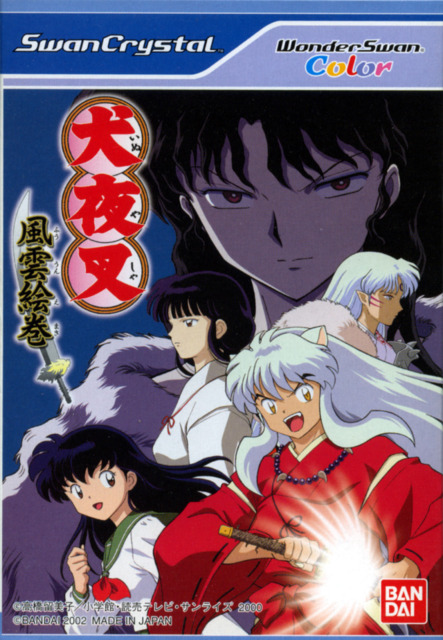
("Inuyasha: Wind and Cloud Picture Scroll")
- Developer: Bandai
- Publisher: Bandai
- Release Date: 2002-07-27
- Inscrutability: Maximum
- Is This Anime?: Oh yes. Dogboy was everywhere in the early '00s.
Field Report: It's back down in the anime trenches for us as we take on Inuyasha: Fuuun Emaki. Yes, that's three Us in a row; Japanese can be fun that way. It's the second of three WonderSwan Color games based on the Inuyasha manga and anime, an early staple of Toonami and the like in which the titular half-human, half-dog spirit meets the time-travelling highschooler Kagome and the two are required to go around collecting the pieces of an important sealing gemstone across Sengoku-era (16th century) Japan while encountering dangerous demons and humans both. It was created by Rumiko Takahashi, the mangaka behind Ranma ½, though it offered something a bit darker and more dramatic than the comical transsexual antics of Ranma and company. You know, the whole edgy and emo bit, which I call edgmo for short. I recall a lot of my fellow teens around the time being obsessed with this show; the internet was as full of Inuyasha portals back then as it is today for Demon Slayer or Attack on Titan or whatever the new edgmo YA anime hotness is. (And if you're wondering, no, it's physically impossible to sound older than I do right now.)
This game sees us fairly late in the manga/anime's continuity as Inuyasha and Kagome already have a full posse in tow, though the UI would indicate I've many more left to recruit. It's some kind of action-RPG where you go around a world map looking for trouble and then must fight brawler-style battles in enclosed arenas against either a bunch of mob enemies or a single boss character: I fought against wolves, floating flaming skulls, and some kind of ranger-warrior elf lady who I'd probably recognize immediately if I had any familiarity with the show. Sometimes you could pick other characters to play as but it felt like most of the time I was stuck with Inuyasha; I wonder if there was a way to call in allies for support attacks like it was Marvel vs. Capcom or something. The game looks pretty sharp but man was that combat sluggish (Tales it ain't) and it feels like the only real obstacle to overcome was the ridiculously oversized hitboxes of the enemies: you need to stand far enough way that your sword swings just about hit because otherwise it's too easy to take collision damage.
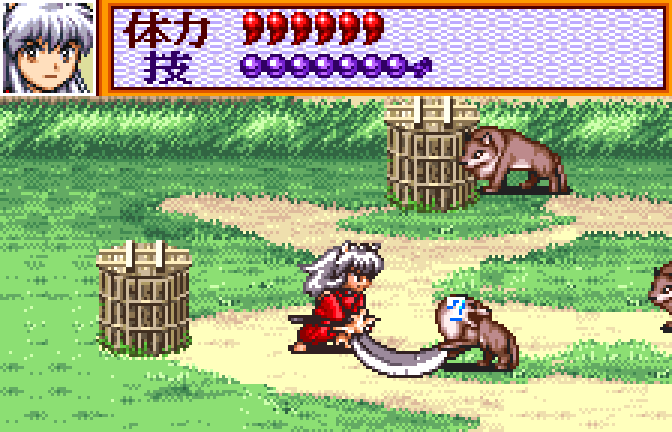
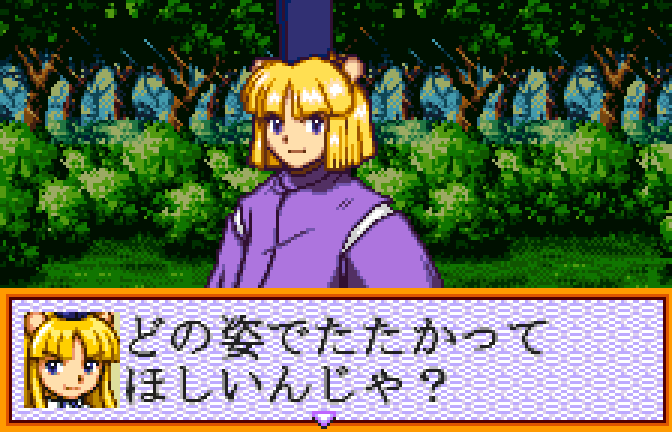
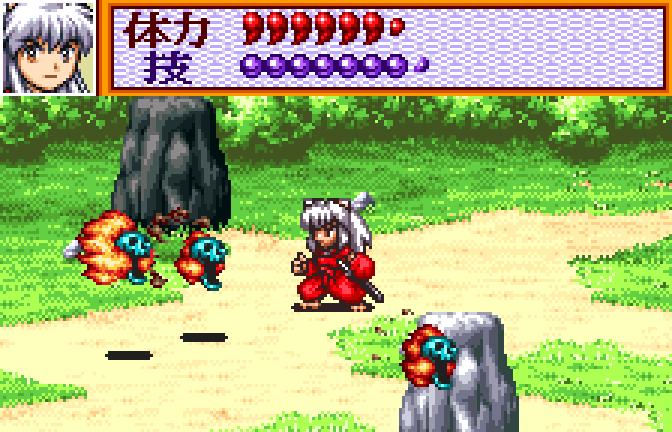
I did level up a few times but without knowing what I was doing and why it wasn't shaping up to be full playthrough material. I'm not sure how you're supposed to figure out where to go either: the world map had no names or icons attached to the nodes you could visit, and there seemed to be no rhyme or reason behind what I found in those places. Maybe the show itself was about wandering around in circles until some boss showed up and dropped a stone fragment McGuffin in the hero party's lap, though I'd have to imagine there was a lot more to it than that if they sold that many wall scrolls at Anime Expo.
Time Spent: Around 10 minutes. I'm going to try to make it at least that far with most of these.
#005: Magical Drop for WonderSwan
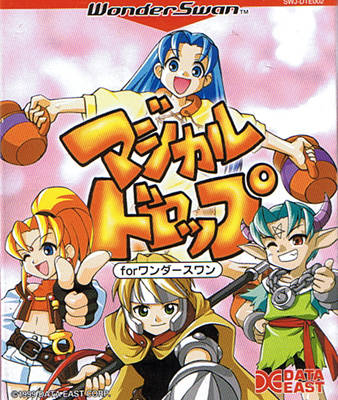
- Developer: Gai Brain
- Publisher: Data East
- Release Date: 1999-10-14
- Inscrutability: Minimum
- Is This Anime?: Feels like it could be, but it's not.
Field Report: Magical Drop is a competitive puzzle game that's a little like Bust-a-Move or Columns but more involves juggling large amounts of magical spheres by pulling them down from the active field and redistributing them to the right columns to create chains that then vanish from the screen. There needs to be a vertical line of at least three of the same symbol for them to activate and disappear, and they'll also take any connecting symbols with them including those horizontally adjacent. A whole lot of sucking up balls, in short. Money Puzzle Exchanger, a game that I know the former staff of this site were very fond of, was a slightly more complex evolution of the idea. Publishers Data East, who were a more common sight in the arcades but certainly made their presence felt on home consoles, did briefly acknowledge the WonderSwan with this and a Side Pocket port but that was all they had in them. They didn't even develop this Magical Drop port: they left that to Gai Brain, who were better known for porting SNK fighters to non-Neo Geo consoles (as a mostly Neo Geo franchise, I guess Magical Drop fits into their purview). While named for the first Magical Drop, Magical Drop for WonderSwan features characters only introduced in the second and third games for Neo Geo so it's mostly its own bespoke entry. Speaking of which, those two sequels can be bought on PS4, Switch, and Xbox One via Hamster's ACA Neo Geo range. There's also Magical Drop VI, a (fairly pricey) modern entry available on Switch and Steam.
The issue with Magical Drop for WonderSwan is that in regular Magical Drop the different jewels are defined by their colors, with red matching with red and so on. That's not quite feasible on a portable system that only has black and white graphics, and I guess Data East didn't want to wait a year for the WonderSwan Color, so instead Gai Brain found a germane way of fixing the problem by leaning into the game's tarot-based aesthetic—all the characters are named after major arcana, like Justice and Emperor and Chariot—and had the four main colors of the original Magical Drop be instead represented by icons of stars, cups, swords, and wands: that is, the four minor arcana which occupy a similar role as spades, diamonds, etc. do for playing cards. It mostly works, and I'm sure colorblind players appreciated the change, but I think it takes the brain a little longer to parse symbols than it does color. Or maybe that's just me. Brains, huh?
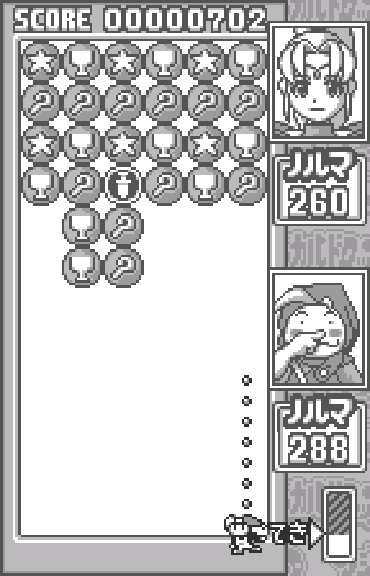
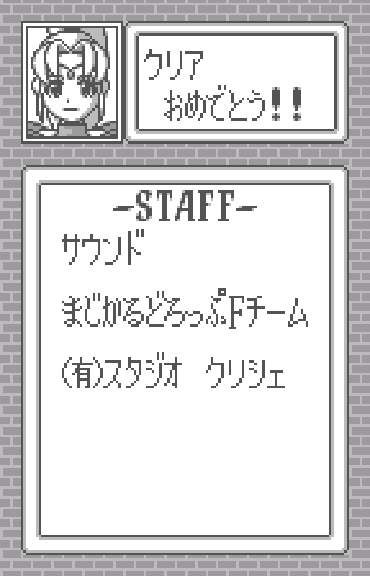
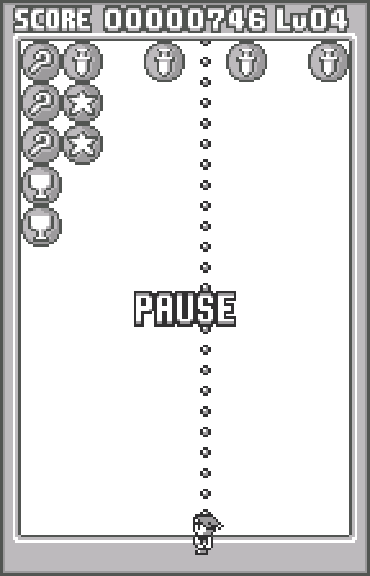
Outside of all that, the gameplay moves fast enough and for as much as I seem to believe that dealing with icons slowed me down I still managed to wipe the floor with every opponent on the story mode's default easy setting. Even normal, though it required a few continues, didn't present much of a challenge. I wondered if I should go for the full set and try for expert but I chickened out and instead checked out solo (hitasura) mode instead: this one gives you more screen estate to work with without an opponent—the "portrait mode" WonderSwan didn't have enough room to display your opponent's grid, but there's a small graphic in the margin that represented how congested their field is as well as a portrait that changes expression depending on how well they're doing—and simply has you deal with waves until you're eventually overwhelmed. I managed to get to level 20, but I don't know how impressive that is. Probably not very. Either way, like I said earlier, simple puzzle games like these are the bread and butter of any pre-millennial portable console's library so this was a good fit. Little reason to play it now though given the better options on Switch and Steam Deck.
Time Spent: Half an hour.
Current Ranking
- Flash Koibito-kun
- Magical Drop for WonderSwan
- Judgement Silversword -Rebirth Edition-
- Inuyasha: Fuuun Emaki
- SD Gundam Eiyuuden: Musha Densetsu
